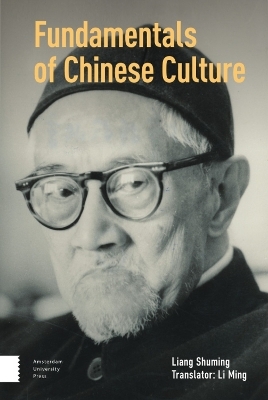
Fundamentals of Chinese Culture
Amsterdam University Press (Verlag)
978-94-6372-965-9 (ISBN)
Liang Shuming (1893-1988) was a noted thinker, educator and social reformist in 20th century China. Liang devoted his lifetime to meditating and exploring two issues: problems in life and problems in China. His books – Oriental and Occidental Cultures and Their Philosophies, An Outline of Indian Philosophy, Theories on Village Construction, Fundamentals of Chinese Culture and Heart and Life – boast a huge audience since their publication.
About Liang Shuming and The Fundamentals of Chinese Culture
Acknowledgements
Profile of the Translator
Contents
Preface to this Translation
Liang's Preface
Chapter One Introduction
1.1 Definition of Chinese Culture
1.2 Specifics of Chinese Culture
1.3 Features of Chinese Culture
1.4 Referential and Supporting Evidence
Chapter Two "Family" to Chinese People
2.1 Fung Yu-lan's Interpretation
2.2 Partiality of Fung's Interpretation
2.3 Formation of Culture and its Characteristics
2.4 A Ladder-like Progress View versus a School-based View
2.5 Additional Remarks
Chapter Three Westerners Living as a Group
3.1 Contrasting Chinese Society and Western Society
3.2 Divide between Chinese Culture and Western Culture
3.3 Christianity and Group-centered Life
3.4 Medieval Society in Europe
3.5 The Seeds of Modern Society
Chapter Four Chinese People's Lack of Group-centered Life
4.1 Westerners' Merits and Our Demerits
4.2 Chinese People's Lack of Group-centered Life
4.3 Incompatibility between Group-centered Life and Family Life
Chapter Five China as an Ethics-Oriented Society
5.1 Definition of Ethics-Orientedness
5.2 Ethics in Economic Life
5.3 Ethics in Political Life
5.4 Ethics as a Religion
5.5 The Ultimate Outcome
Chapter Six Morality as Religion
6.1 Definition of Religion
6.2 Religion in China
6.3 Non-Religious Nature of the Moral Cultivation of the Duke of Zhou and Confucius
6.4 Morality in Place of Religion in China
6.5 Rites of the Duke of Zhou and Confucius
6.6 Organizing Society through Morality
Chapter Seven Rationality - A Human Characteristic
7.1 Definition of Rationality
7.2 Two Inclinations and Two Misconceptions
7.3 Chinese People's National Spirit
Chapter Eight Class Divisions and Professional Distinction
8.1 Definition of Class
8.2 Are There Classes in China?
8.3 Definition of Professional Distinction
Chapter Nine China: A Nation or Not?
9.1 China: Unlike a Nation
9.2 A Nation Derived from Class Rule
9.3 The Collapse of Feudalism in China
9.4 Uniqueness of China's Politics
9.5 Reasons for the Progress of Western Politics
Chapter Ten Governance and Times of Peace and Prosperity
10.1 Chinese Social Structure
10.2 A Life of Inner Discipline
10.3 Splendor in Chinese Civilization
10.4 The Function of Scholars in Chinese Civilization
10.5 Governance versus Times of Peace and Prosperity
Chapter Eleven A Cycle of Times of Peace and Prosperity and Periods of Chaos
11.1 Recurring Periods of Chaos in China
11.2 Lack of Revolutions in China
11.3 Absence of an Industrial Revolution in China
Chapter Twelve Human Cultural Precocity
12.1 Lack of Democracy in China
12.2 Lack of Human Rights and Freedom in China
12.3 Lack of Government by the People
12.4 Human Cultural Precocity
Chapter Thirteen China after Cultural Precocity
13.1 Lack of Science as a Result of Cultural Precocity
13.2 Good at Rationality but Bad at Reason
13.3 Stagnation of Progress in China
13.4 Five Maladies in Chinese Culture
Chapter Fourteen Conclusion
14.1 Summary of Previously Discussed Characteristics
14.2 Shaping of National Character
Select Bibliography
Index
| Erscheinungsdatum | 07.07.2021 |
|---|---|
| Übersetzer | Li Ming |
| Zusatzinfo | 2 Illustrations, black and white |
| Verlagsort | Amsterdam |
| Sprache | englisch |
| Maße | 156 x 234 mm |
| Themenwelt | Geisteswissenschaften ► Geschichte ► Regional- / Ländergeschichte |
| Geschichte ► Teilgebiete der Geschichte ► Kulturgeschichte | |
| Geisteswissenschaften ► Philosophie ► Östliche Philosophie | |
| ISBN-10 | 94-6372-965-8 / 9463729658 |
| ISBN-13 | 978-94-6372-965-9 / 9789463729659 |
| Zustand | Neuware |
| Haben Sie eine Frage zum Produkt? |
aus dem Bereich


